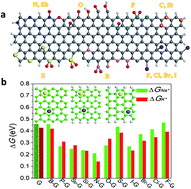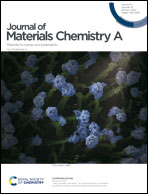Design principles of pseudocapacitive carbon anode materials for ultrafast sodium and potassium-ion batteries†
Abstract
Sodium- and potassium-ion batteries are one of the most promising electrical energy storage devices at low cost, but their inferior rate and capacity have hampered broader applications such as electric vehicles and grids. Carbon nanomaterials have been demonstrated to have ultrafast surface-dominated ion uptake to drastically increase the rate and capacity, but trial-and-error approaches are usually used to find desired anode materials from numerous candidates. Here, we developed guiding principles to rationally screen pseudocapacitive anodes from numerous candidate carbon materials to create ultrafast Na- and K-ion batteries. The transition from pseudocapacitive to metal-battery mechanisms on heteroatom-doped graphene in charging process was revealed by the density functional theory methods. The results show that the graphene substrate can guide the preferential growth of K and Na along graphene plane, which inhibits dendrite development effectively in the batteries. An intrinsic descriptor is discovered to establish a volcano-shaped relationship that correlates the capacity with the intrinsic physical qualities of the doping structures, from which the best anode materials could be predicted. The predictions are in good agreement with the experimental results. The strategies for enhancing both the power and energy densities are proposed based on the predictions and experiments for the batteries.



 Please wait while we load your content...
Please wait while we load your content...